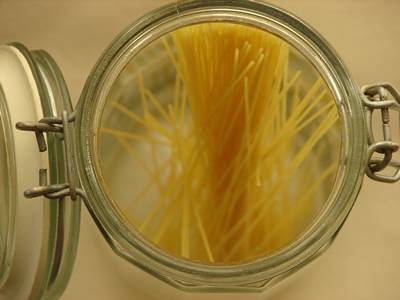Pasta is one of the easiest, quickest and most satisfying meals one can make. Not only are there such a variety of pasta types to choose from,  you can also vary how to serve it to no end (sauce or no sauce, pesto, butter, butter cheese, breadcrumbs etc...) To cook pasta is not very difficult. In fact all you need is one big pot and a stove top. If you have never cooked before or you're just not very comfortable in the kitchen, then starting with pasta is a great idea, simply because it's so easy to do. you can also vary how to serve it to no end (sauce or no sauce, pesto, butter, butter cheese, breadcrumbs etc...) To cook pasta is not very difficult. In fact all you need is one big pot and a stove top. If you have never cooked before or you're just not very comfortable in the kitchen, then starting with pasta is a great idea, simply because it's so easy to do.
How to cook pasta:
First of all fetch a large pot. Pour a generous amount of water into the pot. For one pound of pasta you generally need about 4-6 quarts of water (it does not have to be exact, just pour in a large amount of water). The reason why you want lots of water is because the water gets starchy easily, so you want lots of room for the pasta to move around in.
Put the pot on high heat and wait for it to heat up.
Add salt
Pasta needs salt as it cooks, otherwise you would end up with remarkably flat tasting pasta. Add 2-3 tablespoons of salt in the water. Since you have so much water in the pot, you don't have to be afraid of adding a substantial amount of salt. The water should taste slightly salty, like seawater. Cooking Time
Read the instructions on the box of the pasta. How many minutes should this type of pasta cook? Use this number as a guideline and put a timer on for two minutes less than the recommended time.
Add Pasta
When the water reaches a boil, add the pasta to the water and start the timer. If you're using long spaghetti, then put the pasta in the water (it will stand right up in the pot). As the water softens the pasta, gently move it into the pot so that all the pasta is covered by water. If you're using bow-tie, macaronis or other types of loose pasta, simply pour the pasta from the box into the water.
Stir
Stir with a wooden spoon in the pot to separate the pasta. You want to do this in the beginning and then once in awhile. If you don't stir the pasta in the water it can stick to itself and won't cook properly. Once the pasta is a little softer and separated, you don't need to keep stirring it. What about oil? Many people have been taught you should add a tablespoon of oil to the pasta water to keep the pasta from sticking and the water from boiling over. However, the oil is simply gathered at the top of the water and doesn't really touch the pasta. And if it would touch the pasta, it would simply make it more difficult for a sauce to stick to it. So therefore, don't add oil to the water. It won't really matter either way, but there really isn't any benefit to doing it. Taste
When the time is up for your pasta, taste a piece and see if it's done. If not, let it cook for another minute and then check again. You want the pasta to be slightly al dente (with a bite), but not undercooked.
(Remember! If you're planning on adding the pasta to a pot of sauce then it will continue to cook in the sauce, so it would be a good idea to drain it when it's a touch uncooked and add it to the pot.)
Once the pasta is cooked to your satisfaction, pour the whole pot of water and pasta into a colander and drain well. Serve with your choice of sauce or topping.
|

